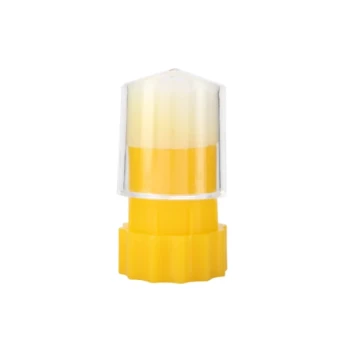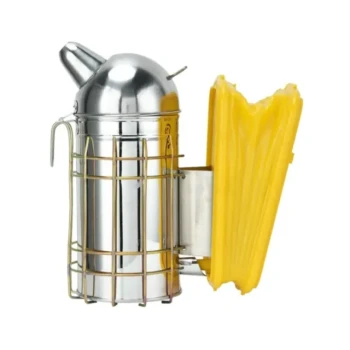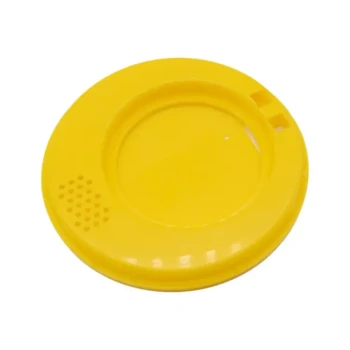At its core, artificial insemination in honey bees is a highly controlled laboratory procedure for transferring semen from selected drones directly into the reproductive tract of a virgin queen. This technique bypasses the randomness of natural mating flights, allowing breeders and scientists to precisely control the genetic parentage of a honey bee colony. The process involves anesthetizing the queen, restraining her in a specialized apparatus, and injecting a measured dose of semen into her median oviduct.
The primary goal of artificial insemination is not simply to mate a queen, but to achieve complete control over colony genetics. This allows for the targeted breeding of desirable traits and the elimination of undesirable ones, a level of precision impossible to achieve with natural open mating.
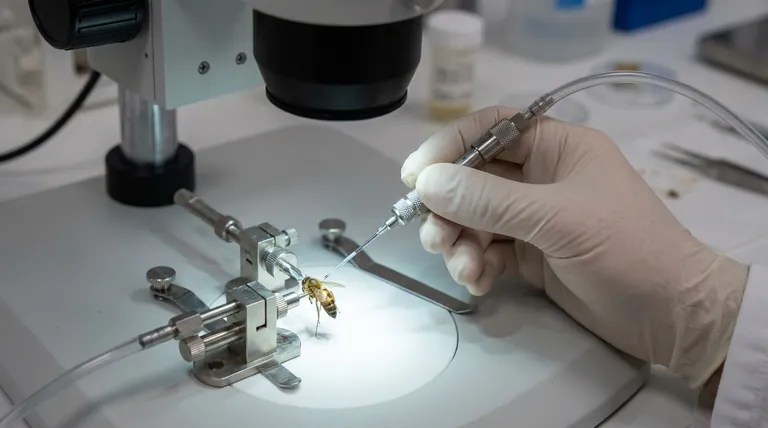
Why Control Honey Bee Mating?
To understand the insemination process, you must first understand the limitations it was designed to overcome.
The Challenge of Natural Mating
A queen bee's natural mating flight is a chaotic event. She flies to a "drone congregation area" and mates with 10-20 different drones from various colonies, including feral ones.
This open mating means a beekeeper has no control over the paternal genetics of their new colony, making it difficult to consistently breed for specific characteristics.
The Goal: Precise Genetic Selection
Artificial insemination (AI) gives breeders absolute control over the paternal side of the genetic equation.
By selecting both the mother queen and the drones that provide the semen, breeders can reliably select for highly desirable traits like disease resistance, temperament, and honey production. A key example is breeding for Varroa Sensitive Hygiene (VSH), a behavior that improves a colony's resistance to the destructive Varroa mite.
Avoiding Undesirable Genetics
Just as important as selecting for good traits is avoiding bad ones. AI prevents queens from mating with drones from poorly managed or aggressive feral colonies, ensuring the genetic integrity of a breeding program.
The Insemination Process: A Step-by-Step Breakdown
The procedure requires specialized equipment, a steady hand, and a deep understanding of bee anatomy. It is a multi-stage process from queen rearing to final introduction.
Step 1: Preparing the Virgin Queen
Queens are reared using standard methods, but they are not allowed to fly freely. They emerge into mating nuclei or cages fitted with queen excluder material.
This barrier is critical, as it prevents the virgin queen from taking a natural mating flight while still allowing worker bees to pass through and care for her.
Step 2: Anesthesia and Priming
When the queen is 5-10 days old, she is anesthetized with carbon dioxide (CO2). This initial gas exposure does not just sedate her; it also physiologically primes her reproductive system and helps stimulate the onset of egg-laying after insemination.
Step 3: The Insemination Procedure
Approximately 24 hours after the initial CO2 treatment, the queen is anesthetized again and carefully restrained in the insemination apparatus.
Using a specialized micro-syringe, the technician injects approximately 8 microliters of semen into the queen's median oviduct. This volume of semen is collected from about 10-12 carefully selected drones.
Step 4: Sperm Migration and Storage
Following the procedure, the queen is held in a controlled environment for another 24 hours. During this time, the sperm migrates from the oviducts into a special organ called the spermatheca.
Here, the queen will store 6 to 8 million sperm, which she will use for the rest of her reproductive life to fertilize eggs.
Understanding Success and Key Considerations
Artificial insemination is a powerful tool, but its success depends on technique and its proper application. It is a specialized practice, not a routine management task.
Measuring a Successful Insemination
The primary measure of success is how quickly the queen begins laying a solid pattern of fertilized eggs (oviposition).
Modern AI techniques are highly refined, and a properly inseminated queen's performance is expected to be comparable to that of a naturally mated queen in terms of egg-laying and colony development.
The Importance of Skill and Equipment
This is not a DIY procedure for the average beekeeper. It requires significant training, a microscope, a CO2 delivery system, and delicate insemination instruments. The viability of both the queen and the sperm depends entirely on the operator's skill.
Making the Right Choice for Your Goal
Artificial insemination is a tool for a specific job. Its value depends entirely on your objective.
- If your primary focus is breeding stock: AI is the essential tool for creating and maintaining specific genetic lines with predictable traits.
- If your primary focus is large-scale honey production: Rely on purchasing well-mated queens from reputable breeders, who in turn use AI to develop their superior stock.
- If your primary focus is scientific research: AI provides the absolute genetic control necessary to conduct rigorous studies on honey bee behavior, health, and disease resistance.
Ultimately, artificial insemination is a cornerstone of modern apiculture, empowering breeders and scientists to guide the evolution of the honey bee in a deliberate and beneficial way.
Summary Table:
| Key Stage | Description | Primary Goal |
|---|---|---|
| Queen Preparation | Rearing a virgin queen in a controlled environment, preventing natural mating flights. | Ensure genetic purity and readiness for the procedure. |
| Anesthesia & Priming | Using carbon dioxide (CO2) to sedate the queen and stimulate her reproductive system. | Prepare the queen physiologically for insemination and egg-laying. |
| Insemination | Injecting a precise dose of semen from selected drones into the queen's median oviduct using a micro-syringe. | Achieve controlled fertilization with desired paternal genetics. |
| Sperm Migration | Holding the queen for 24 hours post-procedure to allow sperm to migrate to the spermatheca for storage. | Ensure long-term fertility and successful egg fertilization. |
| Success Measurement | Monitoring the queen for the onset of consistent egg-laying (oviposition). | Confirm the procedure's success and the queen's viability. |
Elevate Your Apiary's Genetic Potential with HONESTBEE
Artificial insemination is a powerful tool for precise genetic control, but it requires specialized equipment and expertise. Whether you're a commercial apiary focused on breeding superior stock or a distributor supplying the latest beekeeping technology, HONESTBEE is your trusted partner.
We supply high-quality, wholesale-focused beekeeping supplies and equipment essential for advanced breeding programs, including:
- Precision instruments for controlled insemination
- Queen rearing and handling tools
- Laboratory-grade equipment for genetic research
Ready to enhance your breeding program's efficiency and genetic outcomes? Contact our experts today to discuss how our specialized equipment can support your goals in honey bee genetics and productivity.
Visual Guide
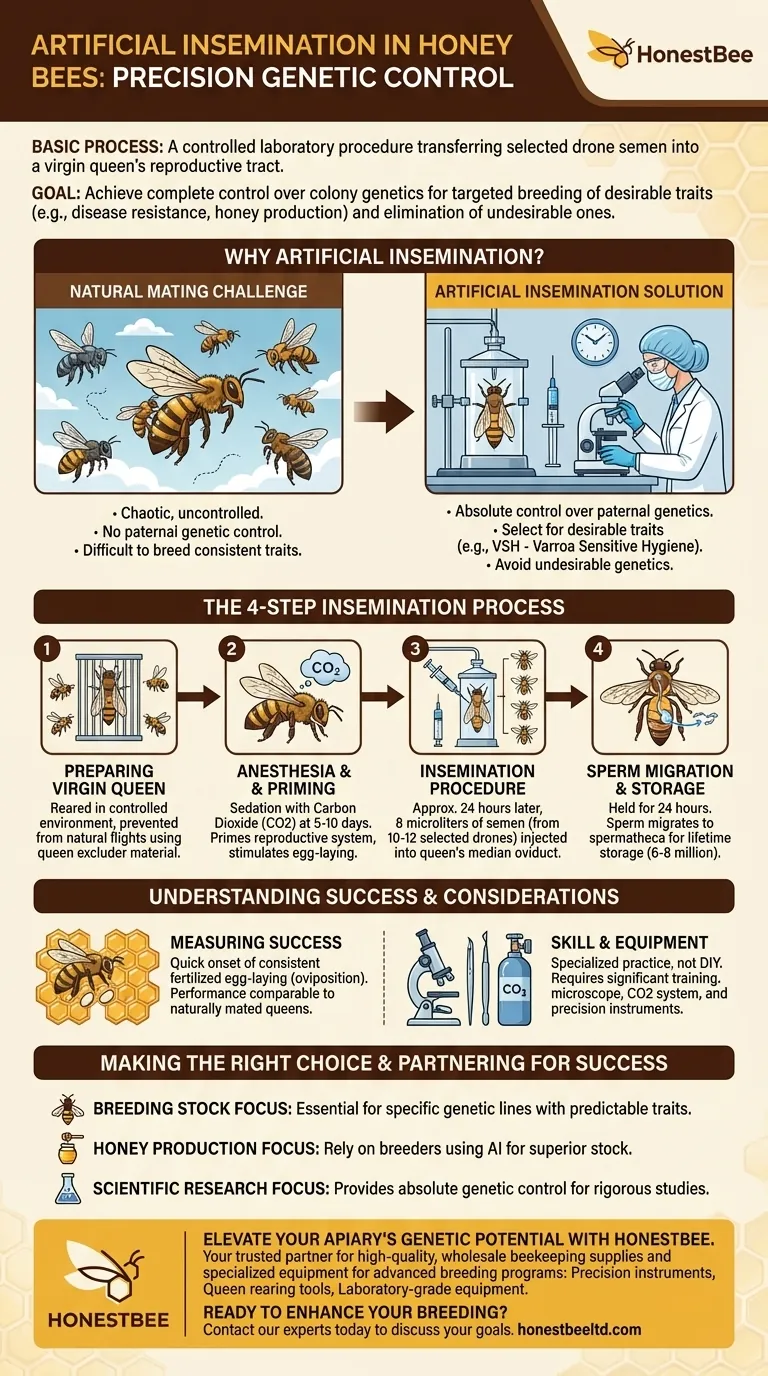
Related Products
- Queen Bee Artificial Insemination Instrument Equipment for Instrumental Insemination
- Plastic Chinese Queen Grafting Tool for Bee Queen Rearing
- Wooden Queen Bee Excluder for Beekeeping
- Professional Spring-Action Queen Catcher Clip
- Plastic Long Marker Device for Catching and Marking Bees Queen Bee Marking Tube and Cage
People Also Ask
- How long does it take to master instrumental insemination? A 2-Year Journey to Queen Rearing Proficiency
- What are the methods for controlling honey bee mating? Mastering Genetic Selection for Your Apiary
- What techniques have been used for semen mixing in artificial insemination? Master the Standard Protocol for Genetic Diversity
- How should the mucus present during semen collection be handled? Avoid Clogs and Ensure Sample Quality
- How is success of honey bee artificial insemination evaluated? From Oviposition to Long-Term Queen Quality





